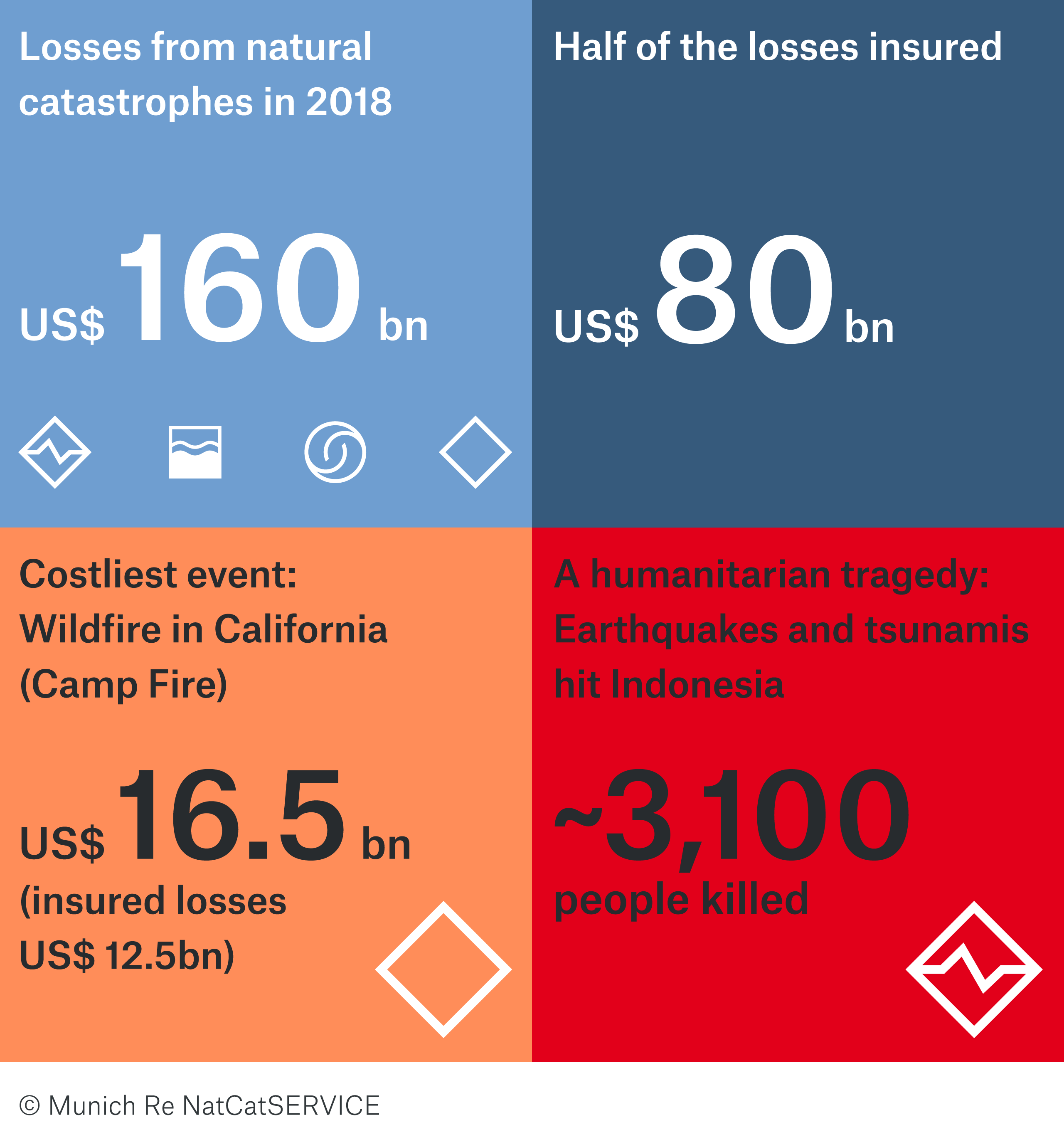Extreme storms, wildfires and droughts cause heavy nat cat losses in 2018
01/08/2019
Reinsurance
properties.trackTitle
properties.trackSubtitle
- Eventful second half of the year contributes to high overall loss figure of US$ 160bn.
- Half of these losses were insured. Loss burden for insurers substantially higher than the long-term average.
- Notably, there are clear indications of the influence that man-made climate change has had on devastating wildfires in California, which, like last year, again caused billions in losses in 2018.

2018 saw several major natural catastrophes with high insured losses. These included the unusual phenomenon of severe tropical cyclones occurring both in the US and Japan while autumn wildfires devastated parts of California. Such massive wildfires appear to be occurring more frequently as a result of climate change. Action is urgently needed on building codes and land use to help prevent losses. Given the greater frequency of unusual loss events and the possible links between them, insurers need to examine whether the events of 2018 were already on their models’ radar or whether they need to realign their risk management and underwriting strategies.
Overview of natural catastrophe figures for 2018

- Overall losses of US$ 160bn were above the inflation-adjusted average for the last 30 years (US$ 140bn). This year’s losses were below the extremely high losses of 2017, which had totalled US$ 350bn and were due mainly to record hurricane losses.
- At US$ 80bn, insured losses were substantially above the inflation-adjusted average for the last 30 years (US$ 41bn), but below last year’s record figures (US$ 140bn).
- Regrettably, some 10,400 people lost their lives in 2018 as a result of natural catastrophes. Compared with the average of 53,000 over the past 30 years, however, a decrease can be seen. This long-term trend is a clear indication that, from a global perspective, measures to protect human life are starting to take effect.
- The deadliest disaster of 2018 was a seven-metre tsunami that took the Indonesian city of Palu by surprise on 28 September following an earthquake nearby. Thousands of buildings were destroyed and some 2,100 people were killed. A further tsunami hit coastal regions of Sumatra and Java – islands of Indonesia – on the evening of 22 December. The metre-high tidal wave is thought to have been caused by an underwater landslide triggered by an eruption of the Anak Krakatau volcano. Since existing tsunami early-warning systems only respond to earthquakes, the metre-high wave caught inhabitants unawares. At least 400 people died.
- The most expensive natural catastrophes occurred in the US: The costliest events were “Camp Fire”, a wildfire in northern California with overall losses of US$ 16.5bn and insured losses of US$ 12.5bn, and Hurricane Michael (overall losses of US$ 16bn, and insured losses of US$ 10bn).
- The sustained drought which caused substantial agricultural losses and many wildfires was Europe’s costliest natural disaster of the year. Direct losses came to US$ 3.9bn (€3.2bn), with only a small proportion of these losses insured. Low water levels on many rivers lasting well into the autumn impacted river traffic and thus also freight transport and the economy.
Worst-ever wildfire season in California – for the second year running
In the autumn, California saw the most damaging wildfires in US history. In early November, the Camp Fire more or less completely destroyed the small town of Paradise in the foothills of the Sierra Nevada about 140 km north of Sacramento. Drought and strong winds helped to fuel the fire, and hilly terrain and limited access routes made it more difficult to put the fire out. On 8 November, authorities ordered the evacuation of the area’s approximately 27,000 residents. Despite this, 86 people were killed. Thousands of homes and cars were gutted by fire. The region has always been threatened by wildfire but had never experienced anything as large or as violent as this. The Camp Fire alone caused overall losses of US$ 16.5bn, with US$ 12.5bn in insured losses, making it the costliest natural catastrophe of the year.
At about the same time, the Woolsey Fire broke out in the Los Angeles area and mainly left its mark in the hills of the celebrity town of Malibu. Around 1,600 houses were destroyed. Due to the high values of the homes involved, overall losses came to US$ 5.2bn, with around US$ 4bn in insured losses. All in all, wildfires in California contributed losses totalling US$ 24bn to the overall 2018 nat cat loss burden, with US$ 18bn of this insured.
Ernst Rauch, head of Climate and Geosciences at Munich Re:
Hurricanes in the US cause one-fifth of overall losses worldwide
From a global perspective, the 2018 cyclone season will be seen as statistically unusual: tropical cyclone activity levels in the world’s different ocean basins usually varies from one place to another in intensity and frequency. This year, however, named tropical storms in all northern-hemisphere ocean basins outnumbered the long-term average. Prominent among these was the high number of typhoons that hit Japan and the two direct hurricane strikes on the US mainland. In total, cyclones worldwide caused above-average overall losses of US$ 56bn. Approximately half of the losses were insured.
Following a relatively quiet start to the North Atlantic season, a flurry of hurricane activity took off in early September. El Niño conditions that normally help to suppress hurricane activity developed too late to inhibit the 2018 season. The costliest event was Hurricane Michael, which reached the US mainland on 10 October on the northwest Florida coast. With wind speeds of 250 km/h, it is the fourth-strongest storm ever to hit the US. The overall loss is estimated at US$ 16bn. Given the extensive wind damage from Hurricane Michael, insured losses came to US$ 10bn as storm cover is widespread in the US both in the private and commercial-industrial sectors.
By contrast, the share of insured losses was much lower from Hurricane Florence, which had hit the North Carolina coast just three weeks earlier. This is because most of the losses caused by Florence were due to flooding caused by Florence’s torrential rains, and insurance against flood damage is much less widespread in the US than windstorm coverage: estimated insured losses of US$ 5bn out of a total of US$ 14bn in overall losses. It would certainly make sense to have higher insurance density against flood losses given that studies have shown the influence of climate change on torrential rainfall events on the Gulf of Mexico coast, such as Hurricane Harvey in 2017.
Japan hit by an unusually high number of natural catastrophes
In 2018 Japan suffered at the hands of both weather-related disasters and geophysical natural catastrophes: A number of typhoons and two earthquakes caused billions in losses.
The typhoon season saw a total of seven storms hit or skirt the islands of Japan in 2018. Five of the storms made landfall or came very close to land with typhoon strength and brought with them torrential rainfall. The development of a particular variant of the climate oscillation El Niño, the central Pacific El Niño, caused circulation conditions that significantly increased the likelihood of a typhoon directly hitting the Japanese mainland. The severest storm was Typhoon Jebi with overall losses of US$ 12.5bn and insured losses of around US$ 9bn, making it one of the costliest typhoons in Japan’s history.
Torrential rainfall in July brought major flooding, especially in the Hiroshima area. Some parts saw as much as almost 2,000 millimetres (litres per square metre) of rain in just 10 days. In total, 11 prefectures were affected by floods and landslides, mostly in the southwest of the main island of Honshu. Losses from the flooding alone amounted to US$ 9.5bn, of which US$ 2.4bn was insured.
Weather-related catastrophes aside, two earthquakes in Japan also caused losses of US$ 9bn in total and insured losses of nearly US$ 2bn. Thanks to the strict building standards in Japan, damage was limited.
The Philippines were hit by Super Typhoon Mangkhut (Ompong) with wind speeds of up to 270 km/h. Despite hundreds of thousands of people being evacuated, about 100 people lost their lives in this (highest) Category 5 tropical storm. Despite the high number of casualties, this event actually showed that early warnings and timely evacuation measures can help to avoid tragedies such as that caused by Typhoon Haiyan in 2013 with its more than 6,000 fatalities.
In Europe, a long, hot and exceptionally dry summer caused billions in losses, especially in agriculture. Following a long winter, spring soon saw summer-like temperatures in large parts of Europe. Many countries had virtually no rain for several months. Cereals and field crops ripened too early, and fodder for livestock became scarce in many regions. In some places, there were partial or even complete crop losses. Rivers had too little water and prices for commodities such as petrol and diesel drastically increased after ships were unable to carry full loads until as late as the autumn. This also negatively impacted many companies, which were not covered against such weather fluctuations. In Scandinavia, the drought led to violent wildfires.
The droughts caused direct losses of US$ 3.9bn (€3.2bn), which does not include indirect losses through lost production or high commodity prices. Only a fraction of these losses was covered (US$ 280m, €230m), as in many countries farmers only take out insurance against individual perils, usually hail. As agriculture is likely to suffer even greater effects of climate change, such as longer droughts, multi-peril insurance systems that also cover drought would certainly make sense. However, these can only work with co-financing from the public sector. Some countries, for example the US, have already introduced successful systems of this kind. Schemes co-financed by the government also exist in some EU countries, where drought is now an insurable risk.
Munich Re is one of the world’s leading providers of reinsurance, primary insurance and insurance-related risk solutions. The group consists of the reinsurance and ERGO business segments, as well as the capital investment company MEAG. Munich Re is globally active and operates in all lines of the insurance business. Since it was founded in 1880, Munich Re has been known for its unrivalled risk-related expertise and its sound financial position. It offers customers financial protection when faced with exceptional levels of damage – from the 1906 San Francisco earthquake to the 2017 Atlantic hurricane season. Munich Re possesses outstanding innovative strength, which enables it to also provide coverage for extraordinary risks such as rocket launches, renewable energies, cyberattacks, or pandemics. The company is playing a key role in driving forward the digital transformation of the insurance industry, and in doing so has further expanded its ability to assess risks and the range of services that it offers. Its tailor-made solutions and close proximity to its customers make Munich Re one of the world’s most sought-after risk partners for businesses, institutions, and private individuals.
Disclaimer
This media information contains forward-looking statements that are based on current assumptions and forecasts of the management of Munich Re. Known and unknown risks, uncertainties and other factors could lead to material differences between the forward-looking statements given here and the actual development, in particular the results, financial situation and performance of our Company. The Company assumes no liability to update these forward-looking statements or to make them conform to future events or developments.